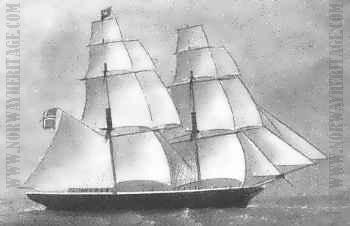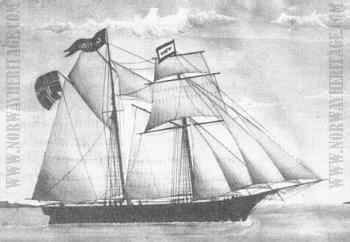|
Commercial lasts - Burden - Tonnage
Bark
Ship
Brig
Schooner
Between Deck - Steerage
Burden - Commercial lasts - Tonnage
"Kommerselester" or "Commercial lasts", is a measurement for the inside volume of the ship. It was recognized as the ships burthen or burden. 1 Norwegian Commercial last = 2,08 register ton = 165 Cu ft of cut board or I30 cu,ft of round timber.
There were restrictions on how many passengers a ship could carry. This is what the US Passenger Act of 1819 says about this.
SEC.1. Be it enacted by the Senate and House of Representatives of the United States of America, in Congress assembled. That if the master or other person on board of any ship or vessel, owned in the whole or in part by a citizens of the United States, or the territories thereof, or by a subject or subjects, citizen or citizens, of any foreign country, shall, after the first day of January next, take on board of such ship or vessel, at any foreign port or place, or shall bring or convey into the United States, or the territories thereof, from any foreign port or place; or shall carry, convey, or transport, from the United [States] or the territories thereof, to any foreign port or place, a greater number of passengers than two for every five tons of such ship or vessel, according to custom house measurement, every such master, or other person so offending, and the owner or owners of such ship or vessels, shall severally forfeit and pay to the United States, the sum of one hundred and fifty dollars, for each and every passenger so taken on board of such ship or vessel over and above the aforesaid number of two to every five tons of such ship or vessel; to be recovered by suit, in any circuit or district court of the United States, where the said vessel may arrive, or where the owner or owners aforesaid may reside: Provided, nevertheless, That nothing in this act shall be taken to apply to the complement of men usually and ordinarily employed in navigating such ship or vessel. And from the British Passenger Act of 1828
...That no Ship shall sail from any Port or Place in the United Kingdom, or in the Islands of Guernsey, Jersey, Alderney, or Sark, or in the Isle of Man, on any Voyage to or for any Port or Place in His Majesty's Possession on the Continent or Islands of North America, with more Persons on board than the Proportion of Three Persons for every Four Tons of the Registered Burthen of such Ship.... And here from the Norwegian passenger act of May 23rd, 1863. - Transportation of passengers to foreign parts of the world:
§1
No vessel, that is intended to transport passengers from a Norwegian port, to countries outside Europe, must carry more than one adult passenger, hereunder master crew and cabin passengers included, for each Commercial last of burden,
§2
The available space for each adult passenger must not be less than 12 ft² on the upper between deck, and on the lover between deck not less than 30 ft². If the ship is carrying other cargo in addition to the passengers...
Dimensions like length, beam and depth for ships are most often given in feet.
Ship types - rigging of sailing vessels: This introduction does not include steamships (S/S). Note: the abbreviation S/S for steamship in English, is often used for sailing-ship (Seilskib or Seilskib) in Norway. The Norwegian abbreviation for steamship is D/S (Dampskib)
|
|
This vessel is a typical Bark. The reason why this ship is called a bark is the way it is rigged. It has three masts, with the foremast and mainmast square rigged and the mizzenmast fore-and-aft rigged. It wasn't unusual for Barks to be re-rigged as Ships or vice-versa. A "bark" rigged vessel, could sail with fewer crew members than the "ship" rigged.
|
Ship (Norw: Skib, Skip, Fregattskib, or Fullrigger) |
This picture shows a Ship. This Ship is square rigged on all three masts, and it has a gaff sail on the mizzen mast. It was often called a "full rigged ship" or in Norwegian "fullrigger" and "fregattskib". A "ship" is a vessel of at least three square rigged masts, each composed of a lower-mast, top-mast, and topgallant mast. Each is outfitted with a yard and a full complement of square sails. Many ship rigged vessels were converted to barks to reduce the number of crew member, and therefore will appear both as a ship and a bark in the lists.
NOTE: in some cases when working with the different sources the term ship (or skib) can be used in the meaning "vessel", and not actually used to a specify the kind of rigging. This may cause some errors to be made when describing the rigging of ships
|
|
|
The brig was usually a much smaller vessel than the bark and ship rigged vessels. The brig is a vessel with two masts (fore and main), both of which are square rigged. The foremast is made in three spars and square-rigged. On the mainmast there is a standing gaff to which is rigged a small fore-and-aft sail.
|
|
|
This is a schooner with topsails. It has two masts, the mainmast of which has a fore-and-aft mainsail and gaff topsail identical to those of an ordinary schooner. The schooner was usually smaller than the brig, bark and ship rigged vessels.
|
This section of this article has been reorganized and moved: Steerage Passengers - Emigrants Between Decks
|



